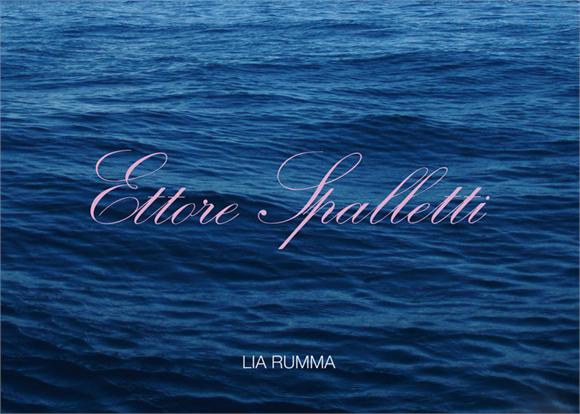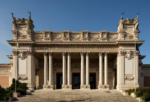Ettore Spalletti

“Un giorno ho visto Spalletti disporre i cavalletti in studio in modo diverso. Gli ho domandato il motivo. Mi ha risposto che lavorava alla mostra per la galleria di Lia Rumma a Napoli. Ha voluto che lo spazio fosse vuotato e che il pavimento fosse lavato”. Azzurra Ricci
Comunicato stampa
Un giorno ho visto Spalletti disporre i cavalletti in studio in modo diverso. Gli ho domandato il motivo. Mi ha risposto che lavorava alla mostra per la galleria di Lia Rumma a Napoli. Ha voluto che lo spazio fosse vuotato e che il pavimento fosse lavato. Lo osservavo passeggiare nello studio in cerca di una luce, di un’ombra, come per trovare un’immagine per poi liberarsene un attimo dopo. La geometria dello studio poco a poco veniva scomposta dai tagli ordinati dei cavalletti. Ho sentito che aveva già precisato un percorso ma non riuscivo ancora a comprenderlo. Spalletti prepara le tavole meticolosamente, il retro viene coperto perchè non ama le sbavature. Dipinge tenendo le tavole in orizzontale, mi spiega che in questo modo la pasta di colore si stende meglio: “il colore si stende, asciuga, ispessisce, riposa”. L’impasto di colore viene dato sulle tavole, quasi alla stessa ora, per dieci o quindici giorni, fino ad ottenere uno spessore che non consente di capire se “il colore dalla superficie si muove verso l’interno del quadro o se dall’interno si muove verso l’esterno”. I tempi di essiccazione determinano quella leggera trama che traspare sulla superficie. Su quei cavalletti ha cominciato a posizionare le tavole, di diverso formato, ciascuna preparata con una cornice diversa, alcune rastremate, altre a sbalzo, altre ancora sottili su un lato e più spesse sull’altro. Ai miei occhi sfuggiva il disegno complessivo. Così Spalletti ha iniziato a definire i primi colori, uno dopo l’altro, ed a stenderli, uno dopo l’altro. Quando prepara l’impasto di colore gli abiti non vengono toccati dalla vernice, i gesti sono meditati, il dosaggio è sapiente. I primi colori erano tenui, un rosa impalpabile, un azzurro acquatico, seguiva un rosso porpora, poi il grigio che “meglio di tutti gli altri colori riesce ad accogliere”, infine il bianco sull’idea verticale della colonna e sulla pietra di alabastro tinta solo per metà. I colori però non erano ancora leggibili, soltanto dopo l’abrasione, quando i pigmenti si rompono e si distribuiscono come polvere di colore sul quadro, il bianco del gesso contenuto nell’impasto li fa vibrare. Quando d’improvviso i colori si sono rivelati nel loro definitivo cromatismo, Spalletti mi ha guardato accennando un sorriso: “d’incanto l’incanto di aver trovato una foglia di acanto”. Sulle cornici andava poi ad adagiarsi il luccichio della foglia d’oro o la rotondità della pasta d’argento. Le tavole, distese, una di fianco all’altra, lasciavano già intuire la loro ragione, poi, una volta appoggiate sulla parete, una dietro l’altra, d’improvviso si sono manifestate in tutta la loro presenza. L’andamento delle cornici imprimeva il movimento, l’oro andava a riflettersi sul muro, il colore viaggiava su di esse. In quel momento, come in una apparizione, tutto si è svelato. Ciò che prima non riuscivo a cogliere era lì di fronte a me come un tutt’uno. E’ stato soltanto allora che Spalletti mi ha detto che il suo desiderio era quello di far correre i colori lungo le pareti della galleria “come a dipingere un solo quadro”.
Azzurra Ricci
Mostre personali sono state dedicate a Spalletti (Cappelle sul Tavo, 1940) da istituzioni prestigiose come Museum Folkwang, Essen (1982), Museum Van Hedendaagse, Gent (1983), Kunstverein, Monaco (1989), Portikus, Francoforte (1989), ARC, Parigi (1991), IVAM, Valencia (1992), Guggenheim Museum, New York (1993), MUHKA, Anversa (1995), Museo di Capodimonte, Napoli (1999), Musée de Strasbourg (1999), Fundaciòn La Caixa, Madrid (2000), Henry Moore Foundation, Leeds (2005), Villa Medici, Roma (2006), Museum Kurhaus Kleve (2009). Diverse le partecipazioni a mostre internazionali, tra cui Documenta VII (1982) e IX (1992), Kassel e la XL (1982), XLIV (1993), XLVI (1995), XLVII (1997) Biennale di Venezia.
............................
One day I saw Spalletti arranging his easels in the studio in a different fashion. I asked him why. He replied that he was working on the exhibition for the Lia Rumma gallery in Naples. He wanted the space to be emptied and the floor to be washed. I observed him as he walked around the studio in search of light and shadow as if he was trying to find an image and then liberate himself from it the very next moment. The geometry of the studio gradually was decomposed by the regular edges of the easels. I felt that he had already defined a sequence although I still could not understand it. Spalletti prepared the paintings meticulously. The rear of the painting was covered because he does not like smudges. He paints with the canvas placed horizontally; he explains that in this way the paint can be spread on more evenly: “the paint is spread, it dries, thickens and settles”. The paint is applied to the canvases, almost at the same hour, for ten or fifteen days, until it reaches a thickness that makes it impossible to understand whether “the colour of the surface is moving towards the inner part of the painting or whether the inner part is moving towards the outside”. The drying times creates the slightly loose-textured effect that appears on the surface. He began to position the paintings on the easels. Each painting had a different format and was prepared with a different frame, some of them tapered, some embossed, others thin on one side and thick on the other. I was unable to grasp the overall design. So Spalletti began to define the first colours, one by one, and spread them on, one after the other. While he was preparing the paint, his clothes were not touched by the paint. The gestures were meditated and the quantities were carefully chosen. The first colours were delicate, a very light pink, a watery blue, followed by crimson, then grey which “manages to absorb more than all the other colours” and, lastly, the white on the vertical idea of the column and on the alabaster, which is only half-painted. However, the colours were still not intelligible; only after the abrasion, when the pigments break up and are distributed like powder paint on the painting, the white of the chalk contained in the mixture begin to make them resonate. When the paints suddenly became clear in their definitive chromatic sense, Spalletti looked at me with a half-smile and said, “d’incanto l’incanto di aver trovato una foglia di acanto” (as if by some enchantment, the enchanting discovery of finding an acanthus leaf). The glitter of the gold leaf or the rotundity of the silver substance settled on the frames. The paintings, arranged one beside the other, left the viewer to guess the meaning; then, once they had been placed on the wall, one behind the other, they suddenly manifested themselves with the entire force of their presence. The pattern of the frames determined the movement, the gold began to be reflected on the wall, the colour travelled on them. At that moment, as if in a vision, all was revealed. Everything that I had previously been unable to comprehend stood before me as a unified whole”. It was only then that Spalletti told me that his intention was to make the colours run along the walls of the gallery “like painting a single picture”.
Azzurra Ricci



